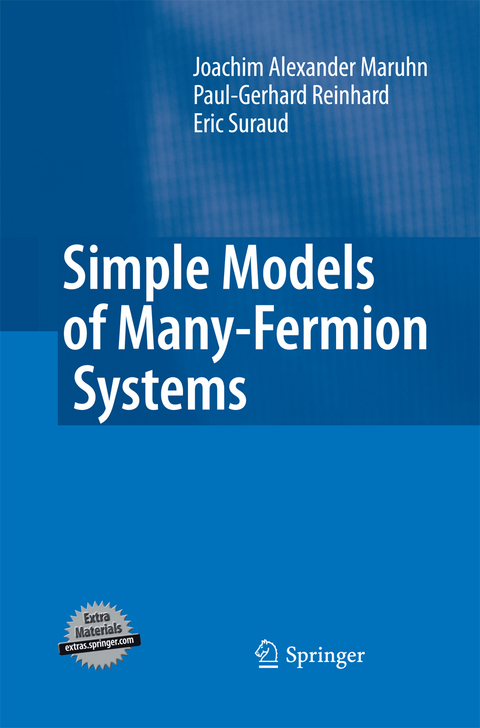
Simple Models of Many-Fermion Systems
Seiten
2014
|
2010
Springer Berlin (Verlag)
978-3-642-43530-0 (ISBN)
Springer Berlin (Verlag)
978-3-642-43530-0 (ISBN)
In this user-friendly guide to the physics of many-particle systems, the material is developed along simple and generic models which illuminate the basic mechanisms behind each approach and which apply to a variety of systems in physics and chemistry.
The term " nite Fermi systems" usually refers to systems where the fermionic nature of the constituents is of dominating importance but the nite spatial extent also cannot be ignored. Historically the prominent examples were atoms, molecules, and nuclei. These should be seen in contrast to solid-state systems, where an in nite extent is usually a good approximation. Recently, new and different types of nite Fermi systems have become important, most noticeably metallic clusters, quantum dots, fermion traps, and compact stars. The theoretical description of nite Fermi systems has a long tradition and dev- oped over decades from most simple models to highly elaborate methods of ma- body theory. In fact, nite Fermi systems are the most demanding ground for theory as one often does not have any symmetry to simplify classi cation and as a possibly large but always nite particle number requires to take into account all particles. In spite of the practical complexity, most methods rely on simple and basic schemes which can be well understood in simple test cases. We therefore felt it a timely undertaking to offer a comprehensive view of the underlying theoretical ideas and techniques used for the description of such s- tems across physical disciplines. The book demonstrates how theoretical can be successively re ned from the Fermi gas via external potential and mean- eld m- els to various techniques for dealing with residual interactions, while following the universality of such concepts like shells and magic numbers across the application elds.
The term " nite Fermi systems" usually refers to systems where the fermionic nature of the constituents is of dominating importance but the nite spatial extent also cannot be ignored. Historically the prominent examples were atoms, molecules, and nuclei. These should be seen in contrast to solid-state systems, where an in nite extent is usually a good approximation. Recently, new and different types of nite Fermi systems have become important, most noticeably metallic clusters, quantum dots, fermion traps, and compact stars. The theoretical description of nite Fermi systems has a long tradition and dev- oped over decades from most simple models to highly elaborate methods of ma- body theory. In fact, nite Fermi systems are the most demanding ground for theory as one often does not have any symmetry to simplify classi cation and as a possibly large but always nite particle number requires to take into account all particles. In spite of the practical complexity, most methods rely on simple and basic schemes which can be well understood in simple test cases. We therefore felt it a timely undertaking to offer a comprehensive view of the underlying theoretical ideas and techniques used for the description of such s- tems across physical disciplines. The book demonstrates how theoretical can be successively re ned from the Fermi gas via external potential and mean- eld m- els to various techniques for dealing with residual interactions, while following the universality of such concepts like shells and magic numbers across the application elds.
All three authors are teaching since many years at various university levels. They also have experience in teaching in international summer schools and they have already written several textbooks in nuclear and cluster physics.
The Variety of Finite Fermion Systems and Their Basic Properties.- The Fermi-Gas Model.- Particles in an External Field.- Approaches Based on Model Spaces.- Hartree-Fock.- Density Functional Theory.- Quasispin Models.- Excitation Spectra.- Coherent Two-Body Correlations.- Conclusions.
| Erscheint lt. Verlag | 26.11.2014 |
|---|---|
| Zusatzinfo | XI, 279 p. |
| Verlagsort | Berlin |
| Sprache | englisch |
| Maße | 155 x 235 mm |
| Gewicht | 450 g |
| Themenwelt | Naturwissenschaften ► Chemie ► Physikalische Chemie |
| Naturwissenschaften ► Physik / Astronomie ► Quantenphysik | |
| Naturwissenschaften ► Physik / Astronomie ► Theoretische Physik | |
| Schlagworte | Atom • Complexity • density functional theory • many-body physics • Many-particle physics • numerical method • Particle physics • Quantum Physics |
| ISBN-10 | 3-642-43530-0 / 3642435300 |
| ISBN-13 | 978-3-642-43530-0 / 9783642435300 |
| Zustand | Neuware |
| Haben Sie eine Frage zum Produkt? |
Mehr entdecken
aus dem Bereich
aus dem Bereich
Quantenmechanik | Spektroskopie | Statistische Thermodynamik
Buch | Softcover (2024)
De Gruyter (Verlag)
59,95 €
Set aus Lehrbuch und Arbeitsbuch
Buch | Hardcover (2022)
Wiley-VCH (Verlag)
109,00 €
Thermodynamik | Kinetik | Elektrochemie
Buch | Softcover (2024)
De Gruyter (Verlag)
59,95 €


